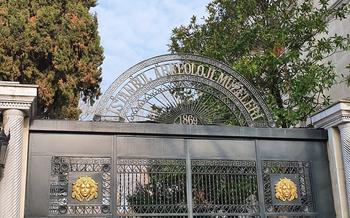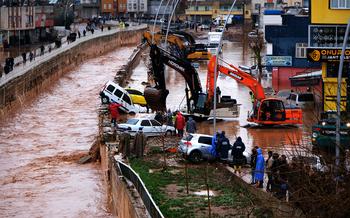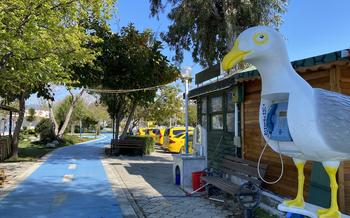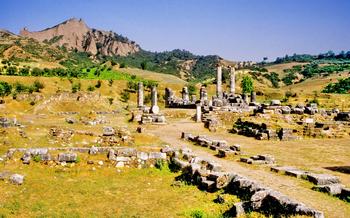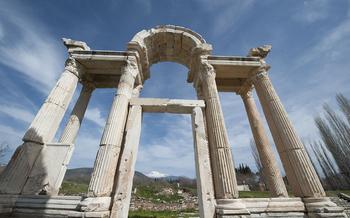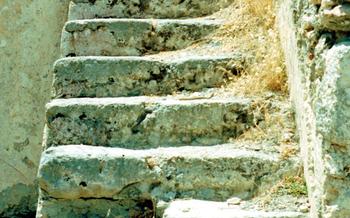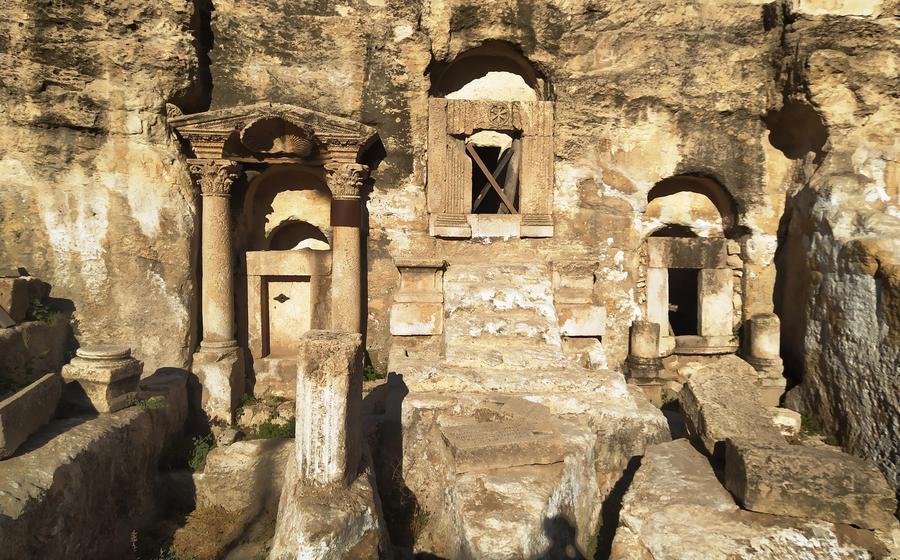
Kızılkoyun Necropolis
- A Journey to the Past: Exploring the Kızılkoyun Necropolis
- The History and Significance of the Necropolis
- Unveiling the Secrets of the Tombs
- The Chamber Tombs: A Glimpse into Ancient Funerary Practices
- The Pillar Tombs: A Testament to Architectural Ingenuity
- The Sarcophagi: Exquisite Masterpieces of Ancient Craftsmanship
- The Mosaics: A Vibrant Tapestry of Art and Symbolism
- The Statues: Guardians of the Dead
- The Jewelry: Adorning the Deceased for the Afterlife
- The Pottery: Vessels for the Living and the Dead
- The Weapons: Symbols of Power and Protection
- The Tools: Insights into Ancient Craftsmanship
- The Coins: A Glimpse into Ancient Economy and Trade
- The Inscriptions: A Window into Ancient Languages and Scripts
- Insider Tip: Unveiling the Hidden Treasures of the Kızılkoyun Necropolis
A Journey to the Past: Exploring the Kızılkoyun Necropolis
The Kızılkoyun Necropolis, nestled amidst the ancient city of Şanlıurfa in southeastern Turkey, is an archaeological treasure trove that invites you on a captivating journey into the past. This sprawling necropolis, dating back to the 9th century BC, served as the final resting place for the city's inhabitants during the Neo-Hittite, Hellenistic, Roman, and Byzantine periods.
The site's significance lies in its remarkable preservation, offering a glimpse into the funerary practices, artistic traditions, and cultural heritage of ancient civilizations. With over 200 tombs of various types, including chamber tombs, pillar tombs, and sarcophagi, the necropolis provides a comprehensive understanding of ancient burial customs.
Getting to the Kızılkoyun Necropolis is a breeze, with its convenient location just 12 kilometers from the city center. Visitors can easily reach the site by taking a short bus ride or driving along the scenic roads leading to this historical gem.
The History and Significance of the Necropolis
The Kızılkoyun Necropolis played a vital role in the ancient city of Şanlıurfa as the primary burial ground for its inhabitants. Its extensive usage spans several historical periods, including the Hellenistic, Roman, and Byzantine eras. During the Hellenistic period, Şanlıurfa, known as Edessa, flourished as a significant cultural and commercial center. The necropolis served as a testament to the city's prosperity and importance.
The cultural and religious significance of the Kızılkoyun Necropolis is intertwined with the beliefs and rituals of the ancient population. The tombs and artifacts discovered provide valuable insights into the funerary practices, beliefs about the afterlife, and religious customs prevalent in the region. The necropolis offers a unique glimpse into the cultural and spiritual world of ancient Şanlıurfa.
To ensure the preservation and protection of this invaluable heritage, the Turkish government has implemented stringent measures. The necropolis has been designated as a protected archaeological site, and ongoing conservation efforts aim to safeguard its structural integrity and prevent further deterioration. Visitors are encouraged to respect the site's significance and adhere to regulations to ensure its preservation for future generations.
Unveiling the Secrets of the Tombs
The Kızılkoyun Necropolis is home to a diverse array of tombs, each with its own unique design and construction. The most common type of tomb is the chamber tomb, which consists of a single chamber carved into the rock. These tombs were typically used for family burials and often contained multiple bodies. The chamber tombs are decorated with elaborate carvings and inscriptions, which provide valuable insights into the beliefs and customs of the ancient people of Şanlıurfa.
Another type of tomb found at the necropolis is the pillar tomb. These tombs are characterized by their distinctive pillars, which are believed to have had a symbolic or religious significance. The pillar tombs are typically larger and more elaborate than the chamber tombs, and they were likely used for the burial of important individuals.
The necropolis also contains a number of sarcophagi, which are stone coffins that were used to hold the bodies of the deceased. The sarcophagi are often decorated with intricate carvings and inscriptions, which provide information about the deceased and their families.
Archaeological excavations have been conducted at the Kızılkoyun Necropolis since the early 20th century. These excavations have uncovered a wealth of artifacts, including pottery, jewelry, weapons, tools, and coins. These artifacts have helped archaeologists to learn more about the daily lives of the ancient people of Şanlıurfa and the funerary practices of the time.
The Chamber Tombs: A Glimpse into Ancient Funerary Practices
The chamber tombs at the Kızılkoyun Necropolis are distinguished by their unique features and elaborate decorations. These tombs consist of a single chamber carved into the rock, with a rectangular or square shape. The entrance to the chamber is typically marked by a large, carved door, often decorated with intricate designs and inscriptions. Inside the chamber, the walls are often lined with benches or niches, where the deceased were laid to rest.
The chamber tombs are particularly notable for their elaborate decorations, which include carvings, paintings, and mosaics. These decorations often depict scenes from mythology, religion, and everyday life. The tombs also contain inscriptions, which provide information about the deceased and their families. These inscriptions are valuable sources of information for archaeologists and historians, as they shed light on the funerary practices and beliefs of the ancient people of Şanlıurfa.
The chamber tombs have been carefully restored and preserved in order to protect their unique features and decorations. Visitors to the Kızılkoyun Necropolis can explore these tombs and gain a glimpse into the ancient funerary practices of the region.
The Pillar Tombs: A Testament to Architectural Ingenuity
The pillar tombs at the Kızılkoyun Necropolis stand as testaments to the architectural prowess of the ancient craftsmen who constructed them. These tombs are distinguished by their unique design, which features a series of pillars that support a massive lintel. The pillars are often elaborately carved with intricate designs and symbols, and they serve to create a sense of grandeur and awe. The lintels are also often decorated with carvings and inscriptions, which provide valuable insights into the lives and beliefs of the individuals buried within.
The pillar tombs at the Kızılkoyun Necropolis vary in size and complexity, but they all share a common design. The pillars are typically made of limestone or basalt, and they are often quite tall, reaching heights of up to 5 meters. The lintels are also made of stone, and they are often quite heavy, weighing several tons. The construction of these tombs required a great deal of skill and engineering knowledge, and the fact that they have survived for centuries is a testament to the quality of their construction.
The pillar tombs at the Kızılkoyun Necropolis are not only impressive from an architectural standpoint, but they also hold great cultural and historical significance. These tombs were used to bury some of the most important and influential people in ancient Şanlıurfa, and they provide valuable insights into the funerary customs and beliefs of the ancient inhabitants of the region. The pillar tombs are also significant because they are some of the best-preserved examples of this type of tomb in the world.
The Sarcophagi: Exquisite Masterpieces of Ancient Craftsmanship
The Kızılkoyun Necropolis is home to a remarkable collection of sarcophagi, each a testament to the skill and artistry of ancient craftsmen. These stone coffins, often intricately carved with mythological scenes, religious symbols, and funerary inscriptions, provide a glimpse into the beliefs and funerary practices of the ancient people of Şanlıurfa.
The sarcophagi vary in size and shape, ranging from simple rectangular boxes to elaborate, house-shaped structures. Some are adorned with intricate carvings that depict scenes from Greek mythology, such as the labors of Hercules or the battle between the gods and the giants. Others feature religious symbols, such as the crescent moon and the star, which were associated with the ancient Mesopotamian goddess Ishtar.
The techniques used to create these sarcophagi were highly sophisticated. The craftsmen would first carve the sarcophagus out of a single block of stone, using a variety of tools including chisels, hammers, and scrapers. They would then use a fine-grained abrasive to smooth the surface of the stone and prepare it for carving.
The carvings were executed with great skill and precision. The craftsmen used a variety of techniques to create different effects, such as bas-relief, in which the figures are raised slightly from the background, and intaglio, in which the figures are carved into the stone.
The sarcophagi at the Kızılkoyun Necropolis have been well-preserved, thanks to the dry climate of the region. However, some of the sarcophagi have been damaged by weathering and erosion, and others have been looted by grave robbers. In recent years, the Turkish government has taken steps to protect the necropolis and its treasures, and many of the sarcophagi have been restored and placed on display in museums.
The Mosaics: A Vibrant Tapestry of Art and Symbolism
Amidst the ancient ruins of the Kızılkoyun Necropolis, exquisite mosaics emerge as a testament to the artistic prowess and religious beliefs of the past. These intricate compositions, meticulously crafted from tiny tesserae, adorn the floors and walls of select tombs, transforming them into vibrant and sacred spaces.
The mosaics depict a wide array of scenes, from mythological tales and religious narratives to pastoral landscapes and everyday activities. Gods and goddesses, heroes and heroines, animals and plants, all come to life in these colorful mosaics, offering a glimpse into the rich tapestry of ancient beliefs and artistic traditions.
One particularly stunning mosaic depicts a hunting scene, where a skilled archer takes aim at a majestic deer amidst a lush forest. The animals are rendered with remarkable detail, capturing their movements and expressions with lifelike precision. The vibrant colors and intricate patterns of the mosaic create a sense of dynamism and energy, immersing viewers in the thrill of the chase.
Another mosaic portrays a religious procession, with a group of figures clad in ceremonial robes carrying offerings and musical instruments. The procession winds its way through a sacred grove, surrounded by trees and flowers rendered in intricate detail. The mosaic's harmonious composition and rich symbolism evoke a sense of reverence and awe, inviting viewers to contemplate the spiritual beliefs of the ancient people who created it.
The mosaics of the Kızılkoyun Necropolis are not merely decorative elements; they are powerful expressions of ancient culture and spirituality. Through these vibrant and enduring artworks, visitors can gain a deeper understanding of the beliefs, values, and artistic traditions of a long-vanished civilization.
The Statues: Guardians of the Dead
Among the many fascinating artifacts unearthed at the Kızılkoyun Necropolis are a collection of exquisitely crafted statues. These statues, carved from a variety of materials including limestone, marble, and sandstone, offer a glimpse into the funerary practices and beliefs of the ancient people of Şanlıurfa.
The statues depict a diverse range of subjects, including gods, goddesses, mythical creatures, and ordinary mortals. Some statues are life-sized, while others are smaller and more delicate. Many of the statues are adorned with intricate details, such as jewelry, clothing, and weapons.
The statues served a variety of purposes in the funerary context. Some were placed in the tombs to protect the deceased from evil spirits. Others were intended to represent the deceased themselves, providing a physical presence for the soul to inhabit in the afterlife. Still others were simply decorative, adding a touch of beauty and elegance to the tomb.
The statues from the Kızılkoyun Necropolis provide valuable insights into the beliefs and practices of the ancient people of Şanlıurfa. They offer a glimpse into the world they inhabited, the gods they worshipped, and the values they held dear.
The Jewelry: Adorning the Deceased for the Afterlife
The Kızılkoyun Necropolis has yielded a rich collection of jewelry, offering glimpses into the personal adornments and cultural practices of the ancient inhabitants of Şanlıurfa. Crafted with exquisite skill and artistry, these ornaments served both as decorative accessories and as symbols of status and wealth, accompanying the deceased into the afterlife.
Necklaces, earrings, bracelets, and rings were among the most common types of jewelry found at the site. These pieces were often made of gold, silver, or bronze, and featured intricate designs incorporating precious stones such as emeralds, rubies, and sapphires. The necklaces, in particular, displayed a remarkable variety of forms, from simple chains to elaborate pendants adorned with gemstones and intricate filigree work.
Jewelry also held deep symbolic and religious significance for the people of Şanlıurfa. Amulets and talismans, believed to possess protective powers, were frequently worn to ward off evil spirits and ensure the safe passage of the deceased into the afterlife. These amulets often depicted religious symbols or figures, such as the crescent moon, the sun, or the Tree of Life.
The discovery of jewelry at the Kızılkoyun Necropolis provides valuable insights into the social customs and beliefs of ancient Şanlıurfa. These exquisite ornaments not only adorned the bodies of the deceased but also held deep personal and symbolic meaning, reflecting the cultural and spiritual beliefs of the ancient inhabitants of this historic city.
The Pottery: Vessels for the Living and the Dead
The Kızılkoyun Necropolis has yielded a wealth of pottery, offering valuable insights into the daily lives and funerary customs of the ancient inhabitants of Şanlıurfa. These ceramic vessels, crafted with skill and artistry, served both practical and symbolic purposes.
Practical Use: Pottery played a crucial role in the daily lives of the people of Şanlıurfa. These vessels were used for storing and transporting food, water, and other essential liquids. They also served as cooking utensils, allowing people to prepare and serve meals. The variety of shapes and sizes found at the necropolis suggests that pottery was adapted to various domestic needs.
Funerary Significance: In addition to their practical use, pottery held significant funerary importance. The ancient people of Şanlıurfa believed that the deceased required provisions for their journey into the afterlife. Thus, pottery vessels were often placed in tombs as offerings to the dead. These vessels contained food, water, and other items believed to be necessary for the deceased's well-being in the hereafter.
Cultural and Artistic Expressions: The pottery discovered at the Kızılkoyun Necropolis is not merely functional but also showcases the artistic talents of the ancient craftsmen. Many vessels are adorned with intricate designs, patterns, and motifs that reflect the cultural and artistic traditions of the region. These decorations provide valuable insights into the aesthetics and symbolism of the ancient people of Şanlıurfa.
Preservation and Protection: The pottery found at the necropolis has been carefully preserved and protected by archaeologists and conservators. These fragile artifacts require specialized handling and storage to ensure their longevity. Conservation efforts focus on stabilizing and restoring the pottery, while maintaining their original appearance and integrity. By preserving these precious artifacts, we can continue to learn about the rich cultural heritage of Şanlıurfa and its ancient inhabitants.
The Weapons: Symbols of Power and Protection
Among the artifacts discovered at the Kızılkoyun Necropolis, weapons hold a significant place, embodying the power, strength, and protection of the deceased in the afterlife. These weapons, including swords, daggers, spears, and arrowheads, were not merely practical tools but also served as symbols of authority, courage, and the ability to defend oneself against evil forces.
The swords, often intricately designed with ornate hilts and blades, were symbols of power and prestige. The daggers, with their sharp and pointed blades, represented the ability to strike swiftly and effectively. Spears, with their long shafts and piercing tips, symbolized the strength and reach of the deceased. Arrowheads, with their aerodynamic design, embodied the skill and precision of the archer.
The presence of these weapons in the tombs suggests that the deceased were believed to need protection and strength in the afterlife, just as they did in the mortal world. They were buried with these weapons to ensure that they would be able to defend themselves against any threats or challenges they might encounter in the realm of the dead.
The discovery of these weapons at the Kızılkoyun Necropolis provides valuable insights into the beliefs and values of the ancient people of Şanlıurfa. They reveal the importance placed on strength, courage, and the ability to protect oneself, even in the face of death.
The Tools: Insights into Ancient Craftsmanship
The Kızılkoyun Necropolis has yielded a rich collection of tools that provide valuable insights into the craftsmanship and daily lives of the people of ancient Şanlıurfa. These tools, made from a variety of materials such as stone, bone, and metal, served various purposes, from agriculture and construction to textile production and metalworking.
Among the most common tools found at the necropolis are grinding stones, used for processing grains and other food items. These stones, often made of basalt or sandstone, exhibit wear patterns that indicate their intensive use. Other tools include hammers, axes, and chisels, which were essential for construction and woodworking.
The presence of needles, awls, and spindles at the site suggests that textile production was an important activity in ancient Şanlıurfa. These tools, made from bone or metal, were used for sewing, weaving, and spinning. Metalworking tools, such as tongs, anvils, and crucibles, have also been discovered, indicating that metalworking was another important craft.
The tools found at the Kızılkoyun Necropolis provide a glimpse into the diverse range of skills and occupations that existed in ancient Şanlıurfa. They offer valuable insights into the daily lives and economic activities of the people who lived in this ancient city.
The Coins: A Glimpse into Ancient Economy and Trade
The Kızılkoyun Necropolis has yielded a treasure trove of coins, providing valuable insights into the economic activities and trade networks of ancient Şanlıurfa. These coins, minted by various city-states and empires, bear witness to the vibrant commercial exchanges that took place in the region.
The majority of the coins date from the Hellenistic and Roman periods, reflecting the city's strategic location along important trade routes. The presence of coins from distant lands, such as Greece, Persia, and Egypt, attests to the far-reaching connections of Şanlıurfa's ancient inhabitants.
The coins depict a variety of motifs, including rulers, gods, and symbols of prosperity. These images offer a glimpse into the religious beliefs, political affiliations, and economic practices of the people who once lived here.
The coins found at the Kızılkoyun Necropolis are not merely historical curiosities; they are tangible remnants of the economic vitality and cultural diversity that characterized ancient Şanlıurfa. By studying these coins, archaeologists and historians can piece together the intricate web of trade and commerce that sustained this ancient city.
The Inscriptions: A Window into Ancient Languages and Scripts
The Kızılkoyun Necropolis is also home to a wealth of inscriptions, offering valuable insights into the languages and scripts of the ancient world. These inscriptions are found on tombstones, sarcophagi, and other funerary objects, and they provide information about the deceased, their families, and their beliefs. Some of the inscriptions are written in ancient Greek, while others are in Aramaic, Syriac, or Latin. These inscriptions have helped scholars to decipher ancient languages and to understand the history and culture of the region.
The inscriptions at the Kızılkoyun Necropolis also provide clues about the religious beliefs of the people who lived in the area. Many of the inscriptions contain references to gods and goddesses, as well as prayers and invocations. These inscriptions shed light on the religious practices and beliefs of the ancient inhabitants of Şanlıurfa.
The inscriptions at the Kızılkoyun Necropolis are a valuable resource for scholars and historians, providing insights into the languages, scripts, and religious beliefs of the ancient world. They are a testament to the rich cultural heritage of the region and continue to captivate and inform visitors to this day.
Insider Tip: Unveiling the Hidden Treasures of the Kızılkoyun Necropolis
Exploring the Kızılkoyun Necropolis on Your Own
For an immersive and rewarding experience, consider exploring the necropolis independently. While guided tours offer valuable insights, venturing on your own allows you to set your pace, soak in the atmosphere, and discover hidden gems that might be overlooked by larger groups.
The Best Time to Visit
Timing is crucial when visiting the Kızılkoyun Necropolis. To avoid the scorching heat and crowds, plan your visit for early morning or late afternoon. As the sun casts long shadows, the necropolis takes on a magical aura, enhancing the overall experience.
Uncovering the Most Impressive Tombs and Artifacts
To make the most of your self-guided tour, focus on the most impressive tombs and artifacts. The chamber tombs, with their intricate carvings and elaborate decorations, are a must-see. Don't miss the pillar tombs, which showcase remarkable architectural ingenuity and symbolism. And keep an eye out for the stunning mosaics, statues, and sarcophagi that adorn the site.
Avoiding the Crowds and Enhancing Your Visit
To avoid the crowds and create a more intimate experience, consider visiting the necropolis during the off-season or on weekdays. This will allow you to explore the site at your leisure, without the distractions of large tour groups. Remember to bring comfortable shoes, as you'll be doing a fair amount of walking on uneven terrain. And don't forget your camera to capture the breathtaking beauty and historical significance of the Kızılkoyun Necropolis.

